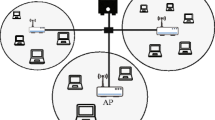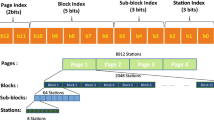Abstract
This paper proposes a Joint Dynamic Resource Allocation (JDRA) algorithm that allocates simultaneously the best-suited Radio Access Technologies (RATs) and amount of resources to all the users active in a multi-access wireless system. Both distributions are performed at the same time so as to make the most of the heterogeneous network. In this scenario users can connect to several RATs but not simultaneously and, therefore, the JDRA algorithm is able to consider the required handover time in the decision making. Moreover, the algorithm guarantees the Quality of Service (QoS) provision in terms of delay and bit rate in a multi-service scenario where different users may have different QoS requirements. Such a complex optimization problem has been tackled using a Hopfield Neural Network (HNN) formulation. These neural networks have fast response times once hardware implemented, which is very significant since current and future wireless networks must rapidly adapt to changing circumstances in wireless environment and traffic. Results prove the benefits achieved by the usage of the HNN-based JDRA algorithm. Firstly, the joint decision outperforms a two-steps procedure in which, after the RAT selection, the same uni-RAT DRA algorithm is applied. Secondly, the proposed algorithm can deal with different levels of congestion and load distribution among RATs in a much better way that other reference algorithms specifically designed for multi-service scenarios.







Similar content being viewed by others
References
Gustafsson E, Jonsson A (2003) Always best connected. IEEE Wireless Communications 10(1):49–55
J. Pérez-Romero, O. Sallent, R. Agustí and M. A. Díaz-Guerra, “Radio resource management strategies in UMTS,” Ed. John Wiley & Sons, 2005
3GPP TR 25.891 v0.3.0 “Improvement of RRM across RNS and RNS/BSS (Post Rel-5),” 2003
C. Mihailescu, X. Lagrange, and P. Godlewski, “Performance evaluation of a dynamic resource allocation algorithm for UMTS-TDD systems,” 51st IEEE Vehicular Technology Conference (VTC), Tokyo. Spring 2000
Parekh AK, Gallager RG (1993) A generalized processor sharing approach to flow control in integrated services networks: the single-node case. IEE/ACM Transactions on Networking 1(3):344–357
Andrews M, Kumaran K, Ramanan K, Stolyar A, Whiting P, Vijayakumar R (2001) Providing quality of service over a shared wireless link. IEEE Communications Magazine 39(2):150–154
Liu Q, Wang X, Giannakis GB (2006) A cross-layer scheduling algorithm with QoS support in wireless networks. IEEE Transactions on Vehicular Technology 55(3):839–847
J. Pérez-Romero, O. Sallent and R. Agustí, “Policy-based initial RAT selection algorithms in heterogeneous networks,” 7th International Workshop on Mobile and Wireless Communications Network (MWCN), Marrakesh. Fall 2005
J. Pérez-Romero, O. Sallent and R. Agustí, “A novel metric for context-aware RAT selection in wireless multi-access systems,” IEEE International Conference on Communications (ICC), Glasgow. Spring 2007
3GPP TS 43.318 V8.2.0, “Generic Access Network (GAN); stage 2.”
3GPP TS 44.318 V8.3.0, “Generic Access Network (GAN); mobile GAN interface layer 3 specification.”
D. Gómez-Barquero, D. Calabuig, J. Monserrat, N. García and J. Pérez-Romero, “Hopfield neural network — based approach for joint dynamic resource allocation in heterogeneous wireless networks,” 64th IEEE Vehicular Technology Conference (VTC), Montreal. Fall 2006
D. Calabuig, J. Monserrat, D. Martín-Sacristán and N. Cardona, “Joint dynamic resource allocation for coupled heterogeneous wireless networks based on Hopfield neural networks,” 67th IEEE Vehicular Technology Conference (VTC), Singapore. Spring 2008
Ahn CW, Ramakrishna RS (2004) QoS provisioning dynamic connection-admission control for multimedia wireless networks using Hopfield neural networks. IEEE Transactions on Vehicular Technology 53(1):106–117
Hopfield JJ, Tank DW (1985) ‘Neural’ computation of decisions in optimization problems. Biological Cybernetics 52(3):141–152
Tan KC, Tang H, Ge SS (2005) On parameter settings of Hopfield networks applied to traveling salesman problems. IEEE Transactions on Circuits and Systems 52(5):994–1002
T.-N. Le and C.-K. Pham, “A new N-parallel updating method of the Hopfield type neural network for N-queens problem,” IEEE International Joint Conference on Neural Networks (IJCNN), Montreal. Spring 2005
Del Re E, Fantacci R, Ronga L (1996) A dynamic channel allocation technique based on Hopfield neural networks. IEEE Transactions on Vehicular Technology 45(1):26–32
Lázaro O, Girma D (2000) A Hopfield neural-network-based dynamic channel allocation with handoff channel reservation control. IEEE Transactions on Vehicular Technology 49(5):1578–1587
Calabuig D, Monserrat JF, Gómez-Barquero D, Cardona N (2008) A delay-centric dynamic resource allocation algorithm for wireless communication systems based on HNN. IEEE Transactions on Vehicular Technology 57(6):3653–3665
Hopfield JJ (1984) Neurons with graded response have collective computational properties like those of two-state neurons. Proceedings of the National Academy of Sciences of the United States of America 81(10):3088–3092
Joya G, Atencia MA, Sandoval F (2002) Hopfield neural networks for optimization: study of the different dynamics. Neurocomputing 43(1):219–237
3GPP2-TSGC5, “HTTP and FTP Traffic Model for 1xEV-DV Simulations.”
S. Choudhury and J. D. Gibson, “Payload length and rate adaptation for throughput optimization in wireless LANs,” IEEE Vehicular Technology Conference (VTC), Melbourne. Spring 2006
F. Brouwer, I. de Bruin, J. C. Silva, N. Souto, F. Cercas and A. Correia, “Usage of link-level performance indicators for HSDPA network-level simulations in E-UMTS,” IEEE International Symposium Spread Spectrum Techniques and Applications (ISSSTA), Sydney. Fall 2004
Author information
Authors and Affiliations
Corresponding author
Rights and permissions
About this article
Cite this article
Calabuig, D., Monserrat, J.F., Martín-Sacristán, D. et al. Joint Dynamic Resource Allocation for QoS Provisioning in Multi-Access and Multi-Service Wireless Systems. Mobile Netw Appl 15, 627–638 (2010). https://doi.org/10.1007/s11036-009-0192-3
Published:
Issue Date:
DOI: https://doi.org/10.1007/s11036-009-0192-3




